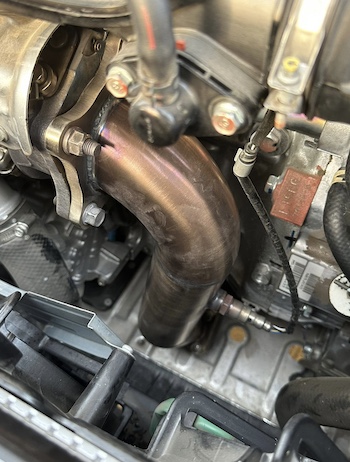The urge to make your Honda Civic faster increases after a defeat from a friend or stranger with the same car or a different one. Trust me, the frustration is accurate as I have gone through this. Did you experience the same, or do you just want to make your Honda Civic fast for your desire? You will need to work on your car to make it run faster. Let’s look at how we can make our Honda Civic faster in no time.
Before we start, let’s look at some stock car upgrades to make the Honda Civic faster.
What Are The Stock Upgrades for Honda Civic 10th & 11th Generation?
1. Change the spark plugs

Changing the plugs after 15,000 miles is essential for the Honda Civic to perform perfectly. The plugs play an important role in the acceleration of the car. The primary function of plugs is to spark to ignite the air-fuel mixture in each cylinder’s combustion chamber.
In simple words, it allows air and fuel to mix up. When the spark plugs are worn out, they do not produce strong sparks, decreasing the car’s performance, including poor fuel efficiency, reduced acceleration, and increased carbon emissions.
So, if your car is not performing above par, check the spark plugs and get them changed if needed. You will see a massive increase in performance after changing them. I have attached some pictures to make it easy for you to figure out the difference between worn-out and fresh spark plugs.
2. Clean Throttle Body
The throttle Body is a very crucial part of the car. It manages the amount of air that enters the engine’s combustion area, controlling the airflow according to the intensity of the accelerator pressed. When you press the accelerator, the throttle plate opens, allowing more air to enter.
When the pedal is released, the throttle plate closes, reducing the airflow. If you feel that the acceleration of your Honda Civic is less, get the throttle body serviced.
After 15-20,000 miles, the throttle body should get a service to get the best output from the car. Carbon deposits, dirt, and oil residue sit on the throttle body and reduce the airflow into the engine, resulting in less acceleration.
After a fresh, cleaned throttle body, the right air will enter the engine, making your Honda Civic faster.
3. Check your engine oil

Always keep a check on your engine oil. Most engine oils have a life of 7,000 miles, but it’s better to change a bit earlier to maintain good engine condition. A good engine oil adds lubrication, keeps the engine healthy, maintains fuel economy, and provides better performance.
Here are some signs that can tell you if you need an oil change or not:
- Always keep an eye on the oil life on the Civic turbo meter
- Loud Engine Noise
- Vibration
- Reduced Fuel Efficiency
- Engine Overheating
Hence, change your oil quickly to get the most out of your car.
4. Clean the intercooler and air filter


The quality of the intercooler and air filter matters significantly to make your Honda Civic faster. The main sources of air to your engine for cooling are the intercooler and the intake. If these air sources are choked by stone chips or dust, there will be more chances of your engine getting heat-soaked after you do a pull on a highway.
Always wash your intercooler with a pressure washer to get all dirt off, and after every 4,000 miles, change your air filter with a genuine Honda one or K&N Filter. After the maintenance of these parts, you’ll see an increase in performance.
5. Get new tires
Tires with good tread and brand are necessary for a Honda Civic to become fast. The main focus is traction. If your car cannot get hold of the road grip, it will spin, resulting in all power loss in the wheel spin. The excessive wheel spin is also dangerous for the CVT. Moreover, tires increase road handling, giving you confidence in your car.
The tire ratings matter a lot. It would be best if you continually keep the same tire rating as the ones the company gave. For 2016-2018 Honda Civics, it is 215/50/16, and for newer models, it’s 215/50/17. So always change your tires quickly and get good ones for maximum power output.
What Are The Performance Upgrades for Honda Civic 10th & 11th Generation?
Now, let’s move on to some hardware/bolt and ECU tune upgrades you can do to make your car faster than ever.
1. Install Air intake

The first and foremost hardware upgrade should be installing an aftermarket air intake. What does an air intake for civic do? It increases the airflow towards the engine, making the air cooler for better performance. The air intake reduces Intake Air Temperature (IAT), which helps the engine perform better than the stock air intake.
The best part about air intake is the added “turbo spool”. The “wshh” sound it produces makes it a must-buy. The car gains around 10-15hp increase with an aftermarket air intake installed. When the IATs are reduced, the engine will not heat soak, and you can do a couple of runs without any worries.
I wrote a guide that includes the top 7 air intakes for civic.
2. Install Intercooler
The second upgrade is a larger intercooler. The intercooler plays the same role but increases the airflow much more than the air intake. It reduces the IATs, as discussed before. The Honda Civic can gain around 20hp with an aftermarket upgraded intercooler without engine heat soak. The intercooler upgrade is a must if you’re living in a hot climate area.
3. Front Pipe & Down Pipe

Further, a catted or de-catted front pipe and a downpipe greatly increase a Honda Civic’s performance. A good upgraded front pipe will allow free-flowing air with reduced exhaust backpressure. The downpipe will gain more horsepower with a change in the engine sound. Front pipe and down pipe increase by around 15 hp.
4. Turbo Upgrade

Upgrading from stock to a bigger turbo is the last upgrade you can do apart from touching the engine. The big turbo and an upgraded inlet pipe give you a massive gain of around 80-100 Wheel horsepower on ethanol with a flex fuel kit.
I wrote a guide that includes everything about the big upgraded turbo for the 11th Generation Civic 2023, give it a read if you plan on installing one.
5. Custom ECU Tuning

At last, with all hardware bolt-ons done, you will need to flash your ECU to get the best performance upgrade. On the Civic, it is done with a K tuner, a device that flashes the ECU with only one touch. The custom ECU tuning is done after checking what your car’s bolt-ons are. With ECU tune, your car can do up to 21 psi of turbo boost with stock turbo and 32 psi with upgraded turbo.
Conclusion
That’s all to make your Honda Civic faster than ever; if you don’t want to break the bank, just go for stock performance upgrades, and if you can afford them, go for bolt-ons. If you have any questions, feel free to comment.

